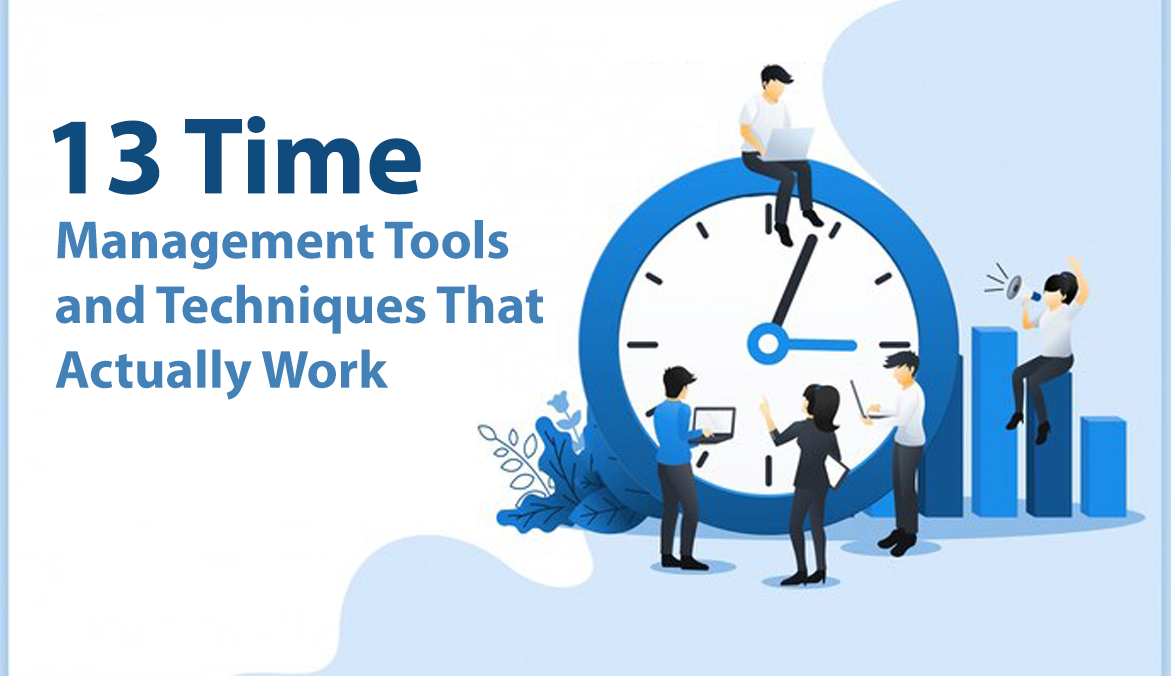Every modern workplace now requires effective time management. However, whether you are an employee, a freelancer, or a project manager, keeping track of time especially when there are a lot of tasks to be done, can be very challenging. In remote work, this would be more complicated. To help you out with effective time management, we have shared some powerful time management tools and techniques that can lower stress and boost productivity.
Understanding the Importance of Time Management
Effective time management can help business owners, employees, managers, or team leaders attain the desired goals. When you manage time wisely, there will be a significant improvement in your work-life balance and it will boost the overall productivity. Different studies have also proved that when employees use the best tools for time management, they lead to better productivity while working in a complex atmosphere with multiple responsibilities and roles. A good time management will allow you to witness the following benefits:
- Increased productivity at work
- Enhanced self-discipline
- Better confidence
- Reduced stress
- Better workflow control
- Fewer or no missed deadline
- Better work-life balance
Now you know about the benefits of time management, let’s talk about some of the best time management tools and strategies that can help you organize your time effectively.
Best Time Management Tools You Can Use
Calendar for Effective Scheduling
Are you searching for an effective task-scheduling tool? You should give Calendar a try. As a perfect Google Calendar alternative, it offers all the required features to help you manage all your appointments. Using this, it would be easier to lower the chances of conflicting meetings. It comes with a Calendar Analytics feature that allows you to optimize your time spent on a task. With its easy-to-use event or meeting templates, one can easily create time slots and share calendar links with employees, clients, or others. With the help of Machine Learning and Artificial Intelligence, it offers a unique scheduling experience.
Evernote to Make Note
If staying on top of your professional and personal responsibilities and tasks is overwhelming, give the Evernote tool a try. This is an excellent note-taking app for creative professionals, managers, or employers. The tool can integrate all your schedules allowing you to remember the important tasks to complete.By offering an organized and focused environment, it empowers users to attain the desired progress. While making notes, you can also configure them based on how you want to view them. Evernote comes with customizable templates, and interactive dashboards, supports multiple data entry modes, and more.
Mera Monitor Time Tracker
Mera Monitor, as one of the best employee monitoring tools, helps employers and managers keep their remote as well as in-office teams productive during working hours. It has simplified the time-tracking process for teams in different locations. The best thing about this time tracker is it creates a perfect balance between productivity monitoring and employee privacy, allowing them not to feel micromanaged while offering them the information they need to optimize their performance. Using Mera Monitor, employees can also keep track of their productivity, and try to upgrade themselves with visual activity reports.
Trello For Project and Task Management
Trello is an easy-to-use yet powerful task management tool. It utilizes the Kanban boards and to-do list styles. This can be an excellent option for project managers or while working on team projects, as every member can track the progress of each task easily. Besides, it comes with a Butler automation feature that allows users to automate multiple tedious or repetitive tasks. What’s more? Using Trello, one can easily create Kanban visuals, Gantt charts, time blocks, and more with a few simple clicks. This tool also supports various third-party integrations and facilitates easy collaboration.
Forest For Concentration
While talking about the best time management tools for employees, we can’t ignore the Forest app. This is an amazing productivity app that can encourage employees to remain on track and focused. The idea here is simple. When you start working, you need to launch the app and plant a virtual tree. The tree will begin to develop as long as you remain focused. If you exit the app or lose concentration, the tree will die. This app helps users to stay away from the phone during working hours. Besides, one can track their past productive records in the app. The app also offers virtual coins. One can collect them and give them back to Forest. They donate that to real tree planting organizations for tree plantation. Till now, more than 1714000 trees have been planted by Forest.
ProofHub For Easy Team Collaboration and Project Management
This widely-used team collaboration, as well as a project management tool, comes with a lot of useful features to provide you with an effective end-to-end project management process. Using this, project managers can organize every project neatly and assign tasks to the right person. Besides, it also helps in time tracking. It keeps the team focused on the work that matters the most. With this tool, businesses can centralize all the project details so that anyone can find the required information quickly. It also supports a real-time chat function.
Time Management Techniques to Consider
POMODORO Technique
As per this time management strategy, you need to divide your entire task into small 25-minute intervals, also called Pomodoros, and then take a break for 5 minutes after completing a Pomodoro. To apply it effectively, first, it is important to understand what you want to attain and then set a 25-minute timer. Begin the task and concentrate on that until the timer beeps. Now, take a break for five minutes. After that, set another 25-minute timer and start working. Repeat the same process for at least 5 times. After completing 4 Pomodoros, you can take a longer break. This strategy helps in improving focus while reducing burnout.
Pickle Jar Theory
This method offers a unique approach to workplace time management. Created in 2002 by Jeremey Wright, this method focuses on prioritizing tasks and considering their urgency or importance for better time management. The major elements within the jar are Rocks (critical tasks), Pebbles (less urgent yet important tasks), Sand (routine tasks), and Water (leisure activities). To successfully apply this strategy, first, you need to begin with Rocks and then add Pebbles. After that, move to Sand. While dealing with the tasks, don’t forget to pour some Water and maintain a work-life balance.
Time Blocking
Time Blocking is an amazing strategy that involves creating multiple blocks of time for a task. Blocking time for the to-dos can help employees understand their workday structure. As a result, they will be able to focus properly and complete the tasks on time. This time management technique is quite simple to apply. First of all, you need to list down the tasks you need to complete and then identify the most important tasks and plan your time for those tasks accordingly. Once you are done with setting time blocks, try your best to follow that schedule. When the first block of time is completed, you can then move to the next task.
Rapid Planning Method
This time management technique focuses on training your brain to completely focus on a vision or goal you want to achieve. When working on a long-term goal, this method can be an ideal option. This strategy includes writing down the tasks a team needs to accomplish within a certain time period. Then, they need to group the tasks based on some commonalities. After that, create RPM blocks and divide them into different categories. Once done, they need to list the Massive Action Plans (MAPs) they want to follow to complete the tasks. To effectively manage the RPM’s MAP components, you can use time management tools for work.
SMART Goal System
The meaning of SMART in the SMART goal strategy is Specific, Measurable, Achievable, Relevant, and Time-Bound. While following this strategy, one needs to clearly define their goals and use numbers or available metrics to measure those goals. It also focuses on creating achievable and realistic goals. Besides, ensure that the goals are relevant to the project and align with their long-term plans. And there should be a time limit or deadline to achieve those goals. The SMART Goal approach helps you eliminate guesswork and generalities, making it easier to identify missed timelines and track progress.
80/20 Rule
The 80/20 rule, also called Pareto Analysis, was developed by Vilfredo Pareto, a famous Italian economist. The idea behind this rule is quite simple. As per this rule., 20 percent of your actions can lead to 80 percent of outcomes. The primary objective of this is to help employees prioritize those tasks that can lead them to attain more results. One can get more done and work smarter by understanding those 20 percent of the things that can bring better results. Then, they can amplify all those tasks that offer better value for the time. Don’t forget to use a time management tool to keep track of your time and progress.
Flowtime Technique
It is an effective time management technique that is ideal for developers, creatives, and teams dealing with projects that require deep concentration. This method focuses on choosing a task and then working on that task until you feel tired and then take a break. You need to follow this process until you are done with the task. The Flowtime technique provides employees with an effective and flexible approach to increase their productivity by aligning working hours with their focus and energy levels.
Conclusion
Proper time management is crucial to attain success. Mastering time management can boost one’s ability to navigate personal development, work as well as leisure. With the best time management tools, you can always meet deadlines, collaborate with team members, and track project progress. These tools can help you avoid those costly delays. Here, we have mentioned 13 easy-to-use and simple-to-follow strategies and tools for time management. Now, it’s up to you to choose the right one based on your requirements and implement it into the workflow. Embrace these tools and strategies, and you will experience that time management is more than just a professional asset.
FAQs
Efficient time management makes it easier to complete a task within the deadlines and can boost a team's productivity. Besides, it also plays an important role in maintaining a work-life balance.
Yes, it is. This is an excellent technique that you can use at your workplace to focus better on a task. It creates a sense of urgency and divides a workday into small focus periods while allowing you to take a break after every focus period.
You can do that by creating an accurate to-do list and assigning a timeline for every task. Besides, you can follow the strategies mentioned above along with the tools to witness better results.
First, you need to prioritize the first 20 percent of the task you want to complete, and when working on the remaining 80 percent of the task, make changes to lower the waste of time.
 Gift Card ₹999
Gift Card ₹999


